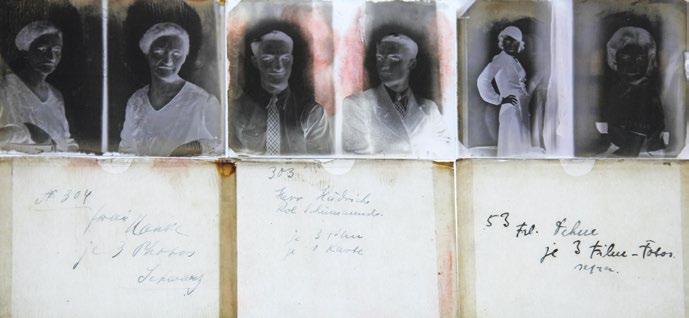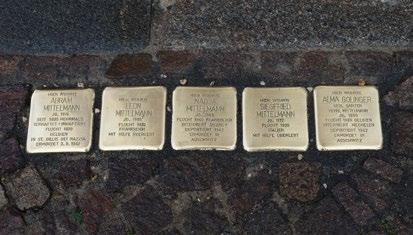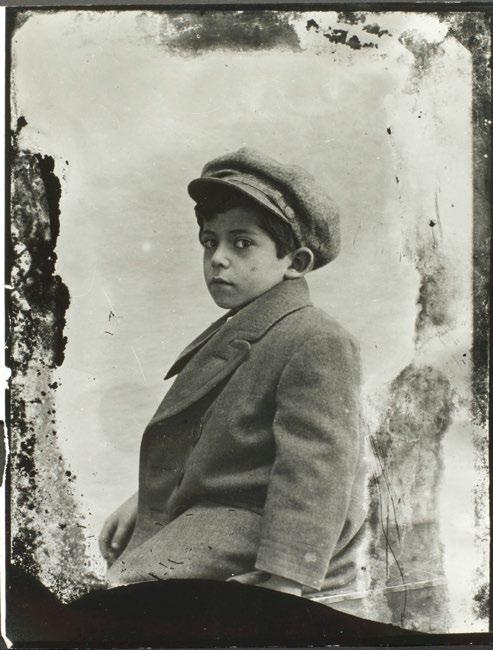
2 minute read
Die historische Bedeutung des
from Historischer Schatz für Leipzig und die Welt - Das Archiv des jüdischen Fotografen Abram Mittelmann
Fotoarchivs
Die wiederentdeckten Portraits und Stadtansichten sind ein Zeitfenster in die Gesellschaft einer deutschen Stadt vor dem Zweiten Weltkrieg. Sie bieten die einmalige Möglichkeit, sie in gemeinsamer Arbeit für die Öffentlichkeit zu erschließen. Lange verborgen, geben sie auch der einst florierenden Leipziger Jüdischen Gemeinde, die von den Nationalsozialisten zerschlagen wurde (von einst über 12.000 Mitgliedern im Jahr 1925 gründeten im Mai 1945 nur noch ca. 20 Menschen die Gemeinde aufs Neue), viele Namen und Gesichter zurück. Beim Betrachten der Fotos wird unweigerlich das folgende Schicksal von Flucht, Vertreibung und Mord bewusst.
Advertisement
The historic importance of the photo archive
The rediscovered portraits and cityscapes provide a glimpse of the society of a German city before World War II. Through our joint work, we now have the unique opportunity to make these photographs accessible to the public. After being lost for so long, they also return the names –and show the faces – of many members of the once flourishing Jewish community in Leipzig so brutally destroyed by the Nazis (In May 1940, only around 20 people re-established the community – compared to more than 12,000 members in 1925). Inevitably, any viewer looking at the photographs will think of their subsequent fate – of flight, persecution and murder.
In das Atelier kamen vor 1933 Frauen und Männer unabhängig von politischen Einstellungen, Religionszugehörigkeit oder Herkunft. Auch die zur Schau getragene neue Selbstsicherheit der uniformierten Nationalsozialist*innen wird hier sichtbar. Das Nebeneinander von »Täterschaft« und »Opfern« vermittelt uns den Zeitgeist und lässt gleichzeitig fragen: Wie konnte auf »Nachbarschaft« erbitterter Hass und Hetze folgen? Forscher*innen finden hier Quellen zur Sozialgeschichte der Zwischenkriegszeit und des Nationalsozialismus.
Die Bedeutung der Sammlung reicht über das wissenschaftliche und bildungspolitische Interesse Leipzigs hinaus. Die Aufmerksamkeit der weltweit verstreuten Nachkommen jüdischer Familien wächst stetig.
Before 1933, people of all political leanings, religious affiliations or social backgrounds visited the studio. Even the new self-confidence exhibited by uniformed Nazis can be seen in the photographs. This co-existence of perpetrators and victims gives an impression of the spirit of the time and raises the question: How could smear campaigns and hatred follow peaceful coexistence? In these photographs, researchers find sources on the social history of the time between the wars and National Socialism.
The importance of the collection transcends mere scientific and educational interests within the city: There is growing interest among the descendants of Jewish families who now live all over the world.

Die Enkel*innen- und Urenkel*innen-Generationen interessieren sich für ihre abrupt endenden Familiengeschichten in Leipzig. Dies belegt die rege Teilnahme am Besuchsprogramm der Stadt Leipzig für ehemalige jüdische Leipziger*innen und deren Kinder. Auch die vielen biografischen Hinweise durch das Erinnerungsprojekt STOLPERSTEINE, durch Ausstellungen und online-Projekte sprechen dafür. Wir sind mit sehr vielen jüdischen Familien weltweit im Kontakt. Die Erwartung liegt nahe, dass wir ihnen helfen können, Bilder ihrer Leipziger Vorfahren wiederzugeben.
The grandchildren and great-grand children’s generations take great interest in their family history in Leipzig which ended so abruptly. This is confirmed by the keen participation of former Jewish Leipzigers and their children in the visiting programmes offered by the city. In addition, the high level of interest is also supported by the manifold biographic data contributed by the STOLPERSTEINE commemoration project, exhibitions and online projects. We are in contact with a great many Jewish families worldwide. All of this leads to the expectation that we might be able to return photographs of their Leipzig ancestors to them.

Working with this great treasure – which is probably unique in the world – involves a high level of responsibility towards our cultural heritage. At the same time, supporting this comprehensive scientific project is a great honour and sign of appreciation from the Leipzig institutions and potential funding agencies.
Die Aufarbeitung dieses wohl weltweit einzigartigen Schatzes ist verbunden mit einer großen Verantwortung gegenüber dem kulturellen Erbe. Gleichzeitig ist es eine große Ehre und Anerkennung für die Leipziger Institutionen und potentielle Mittelgeber*innen, dieses umfangreiche wissenschaftliche Projekt zu unterstützen.
Sigi Mittelmann als Kind / Sigi Mittelmann as a child / Photo: Abram Mittelmann, um / around 1924







